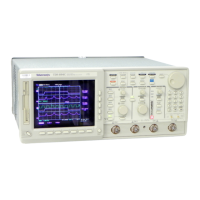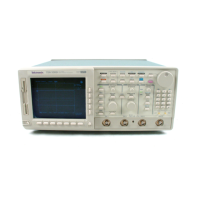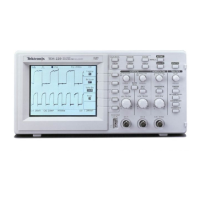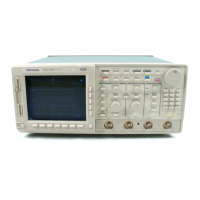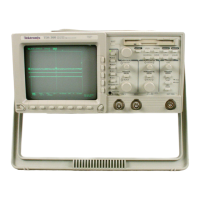Glossary
Glossary–6
TDS 500D, TDS 600B, & TDS 700D User Manual
Hi Res acquisition mode
TDS 500D and TDS 700D Models Only: An acquisition mode in which the
oscilloscope averages all samples taken during an acquisition interval to
create a record point. That average results in a higher-resolution, lower-band-
width waveform. That mode only works with real-time, non-interpolated
sampling.
High
The value used as 100% in automated measurements (whenever high ref,
mid ref, and low ref values are needed as in fall time and rise time measure-
ments). May be calculated using either the min/max or the histogram
method. With the min/max method (most useful for general waveforms), it is
the maximum value found. With the histogram method (most useful for
pulses), it refers to the most common value found above the mid point. See
Appendix B: Algorithms for details.
Holdoff, trigger
A specified amount of time after a trigger signal that elapses before the
trigger circuit will accept another trigger signal. Trigger holdoff helps ensure
a stable display.
Horizontal bar cursors
The two horizontal bars that you position to measure the voltage parameters
of a waveform. The oscilloscope displays the value of the active (moveable)
cursor with respect to ground and the voltage value between the bars.
Interpolation
The way the oscilloscope calculates values for record points when the
oscilloscope cannot acquire all the points for a complete record with a single
trigger event. That condition occurs when the oscilloscope is limited to real
time sampling and the time base is set to a value that exceeds the effective
sample rate of the oscilloscope. The oscilloscope has two interpolation
options: linear or sin(x)/x interpolation.
Linear interpolation calculates record points in a straight-line fit between the
actual values acquired. Sin(x)/x computes record points in a curve fit
between the actual values acquired. It assumes all the interpolated points fall
in their appropriate point in time on that curve.
Intensity
Display brightness.
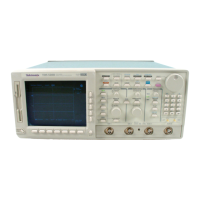
